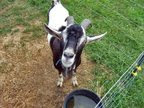While it is true that you can profit from goat –keeping, but caring for goats also means making sure that they are in good health and in the best shape.
Especially for goat herders who either make a living out of keeping goats for producing milk and dairy products, meat, mohair or cashmere, or simply breeding goats for sale, there are things to look out for to know if your goats are in tip top shape or needs medical attention.
Goat herders must be ever vigilant in watching out for signs that will indicate if their goats are in need of medical attention or lack nutrition that they need.
Here are some signs that herders need to look out for.
1. Look for goats that usually fall behind or are well away from the main herd, most especially when goats are being herded together and shows signs of not eating, having an abnormal body posture such as a head hanging down, or even gets separated during herding since these are tell tale signs that something could be wrong. Goats usually separate themselves when they could be suffering from an illness or are pregnant.
2. Always make sure to observe the feces or droppings, if the droppings clump together, scouring (diarrhea) or the droppings are very hard, then something may be wrong. Visit a local veterinarian to see what needs to be done or what needs to be administered.
3. Look at the herd to see if there are goats that lag behind or have problems keeping up with the herd, since these can also show signs of a health problem afflicting the animal. These are usually signs of nutrition deficiency, parasite infestation or contracted a disease.
4. Aside from body signs, you may also need to observe the goats’ feet and legs for signs of swelling may even manifest limping or dragging of the legs and feet.
5. A sudden or inexplicable weight loss in animals, can also be a sign of deteriorating health that affects the goat’s health.
6. Another tip is to also look for signs of swelling underneath the chin, which can be indicative of internal parasites in the stomach or intestines, or an abnormal-sized throat which may be signs of goiter.
7. Another tell tale sign is an abnormal gait that could be limping, staggering or abnormal walking that may indicate tetanus. This could be due to a wound that became infected or has started to contaminate the goat’s blood with the wound infection. This is treatable at an early stage so make sure to have wounds treated with iodine to disinfect the wound with hydrogen peroxide or iodine and prevent it from getting contaminated to avoid infection.
8. A dull or rough coat may indicate underlying disease or deficiencies, which may need immediate attention by a veterinarian
Lastly, look for abnormal discharges especially blood, pus or mucus from the mouth, eyes, ears or vulva, or any other part of the goat’s body, an internal infection can be very dangerous and allows for the rapid deterioration of the goat’s health.
Now you see the importance that caring for goats also means making sure that they are in good health and in the best shape.
Wednesday, September 22, 2010
Caring for Goats also Means Making Sure That They Stay Healthly
Labels:
goat keeping,
health for goat,
medicine for goat
Subscribe to:
Post Comments (Atom)







needs times to implement it...
ReplyDeletebut helpful information...
nice share..